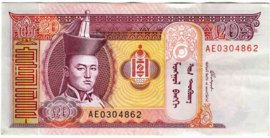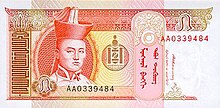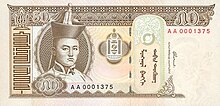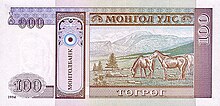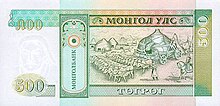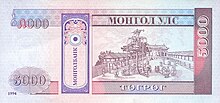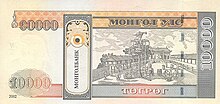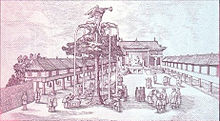Tugrik
| Tögrög (Tugrik) | |
|---|---|
| Country: |
|
| Subdivision: | 100 Möngö (Mongo) |
| ISO 4217 code : | MNT |
| Abbreviation: | ₮ , Tug. |
|
Exchange rate : (29 Mar 2020) |
1 EUR = 3,096 MNT 1 CHF = 2,880 MNT |
The Tugrik or (Mongolian) Tögrög ( Mongolian төгрөг ; written after the Russian name тугрик Tugrik or Tugrig ; currency abbreviation : ₮ ) is the currency of Mongolia and the former People's Republic of Tuva . It was historically divided into 100 Möngö ( мөнгө , German also Mongo ), but the small currency unit is no longer used.
The tugrik is available in banknotes and coins:
- The notes have values of 1, 5, 10, 20, 50, 100, 500, 1,000, 5,000, 10,000 and 20,000 Tugrik. In practice, however, notes below 10 Tugrik are rarely used.
- There are coins with values of 20, 50, 100, 200 and 500 Tugrik. However, these are no longer used in practice.
history
The tugrik was introduced in 1925 and was pegged one-to-one to the Soviet ruble during the period of socialism . It was supposed to replace the previously used foreign currencies, such as the Mexican silver dollar , which is common in China, and the barter of silver pieces and tea bricks .
Since the democratization of the country, the currency has been freely convertible , the initially rapid decline in value has slowed since the end of the 1990s. Between 2000 and 2005 the rate fell from around 1050 MNT / USD to around 1200 MNT / USD. In the meantime (as of July 2017) the exchange rate is around 2350 MNT / USD after another decline in value in mid-2016.
Banknotes (since 1993)
The modern tugrik as the current currency in Mongolia appears mainly in the form of banknotes that have been issued by the Mongolbank, the central bank of the Mongolian state, since 1993. The following nominal values exist so far:
10, 20, 50 Möngö and 1, 5, 10, 20, 50, 100, 500, 1,000, 5,000, 10,000, 20,000 Tugrik.
The smallest common note in circulation is the 10-Tugrik note with a converted value of around 0.3 euro cents (EUR 1 = 2,947 MNT, current annual low on March 20, 2020). The last issue of the 1- and 5-Tugrik notes dates back to 2014, when the equivalent of the 5-Tugrik note was no more than 0.2 euro cents (1 EUR = 2,204 MNT, annual low on 3. January 2014).
layout
1 tugrik
The smallest Tugrik note shows a stylized lion on the front and the Soyombo symbol on the back . This national symbol of Mongolia also forms a central design element on all other banknotes and can be found in the central area to the right of the front portrait. Two further design components are the Mongolian folded lettering crowned by a trident to the left of the portrait on the front and the "little card" in traditional Mongolian script, which separates the main motif from the watermark area on the front and back of each banknote. In addition to the Mongolian writing on the front, the name of the central bank “Mongolbank” (vertical in the so-called card), the country name “Mongol Uls” (above) and the currency “Tögrög” (below) in Cyrillic script can be found on the back of each banknote .
5 to 100 tugrik
The front of the banknotes with the denominations of 5, 10, 20, 50 and 100 Tugrik shows the portrait of Damdiny Süchbaatar , leader of the Mongolian Revolution and founder of the first Mongolian People's Republic in 1921. The reverse shows a herd of horses grazing in a Mongolian steppe landscape Mountains pictured in the background.
The coloring of the individual denominations varies a little more or less in the different years of issue. In addition, since the second edition of the notes in the early 2000s, the paper itself has been colored. The first issue of the Tugrik notes from 1993 was still printed on pure white paper and did not have an issue year, which can be found on the bottom left of all banknotes from 1994 onwards. The 1- and 5-Tugrik notes were printed on white paper until the 2014 edition.
500 and 1,000 tugrik
All banknotes from 500 Tugrik upwards bear the image of Genghis Khan , founder and first Khan of the Mongol Empire in 1206.
The motif on the back of the 500 and 1,000 tugrik notes shows a large ox cart on which a decorated yurt is being pulled. The cart is accompanied by riders on horse and camel. The construction of a yurt settlement can be seen in the background.
Just like the lower values, the banknote paper for the 500 and 1,000 Tugrik notes has been colored green and blue since the year of issue 2003. Up until the year 2000, these notes were printed on white paper. The year of issue on the bottom left of the back is given from 1997.
5,000 and 10,000 tugrik
On the back of the 5,000 and 10,000 Tugrik notes there is an illustration of the historic old town of Karakoram with residents. The focus is
"[...] a silver tree dispensing drinks, crowned by an angel blowing a trumpet [...]".
This drinking fountain is a symbol of the former capital of the Mongol Empire under Genghis Khan, which is now a ruin near the settlement of Kharkhorin in central Mongolia.
Both banknotes have been printed on colored paper since their first appearance with the year 1994 and 1995 respectively.
20,000 tugrik
The 20,000 Tugrik note was first put into circulation with the year 2006 on paper that was already colored. The reverse shows a symmetrical formation of one large and eight smaller tughs or sulden . There are nine flagpoles with white ponytail hair hanging from a round head crowned with a flame or a trident. They are a symbol of times of peace and were only placed in front of a khan's yurt.
The following overview shows the current Tugrik banknotes with technical data since their first appearance in 1993.
1 The average exchange rate in the year of the introduction of modern banknotes, i.e. H. in the period from April to December 1993 was 1 USD = 343 MNT. The following year the rate was USD 1 = 413 MNT, another year later USD 1 = 449 MNT.
literature
- Helmut Kahnt, Bernd Knorr: Old measures, coins and weights. A lexicon. Bibliographisches Institut, Leipzig 1986, licensed edition Mannheim / Vienna / Zurich 1987, ISBN 3-411-02148-9 , p. 378 (on Tugrik and Mongo in Mongolia).
Individual evidence
- ↑ Монголбанк: Bank of Mongolia. Retrieved April 13, 2020 .
- ↑ Монголбанк: Bank of Mongolia. Retrieved April 13, 2020 .
- ↑ XE: EUR / MNT Currency Chart. Euro to Mongolian Tughrik Rates. Retrieved April 13, 2020 .
- ↑ XE: EUR / MNT Currency Chart. Euro to Mongolian Tughrik Rates. Retrieved April 13, 2020 .
- ↑ The silver tree of Genghis Khan | NZZ. Retrieved April 13, 2020 .
- ↑ Devon Field: The Khan's Drinking Fountain. Accessed April 13, 2020 (English).
- ↑ XE: EUR / MNT Currency Chart. Euro to Mongolian Tughrik Rates. Retrieved April 13, 2020 .
- ↑ Mongolia Exchange Rate against USD [1990 - 2020] [Data & Charts]. Retrieved April 13, 2020 .
